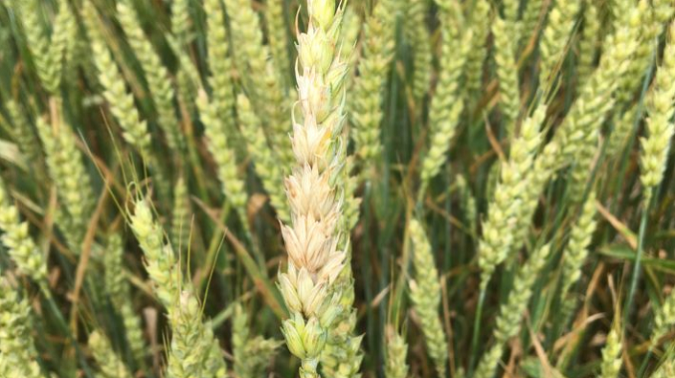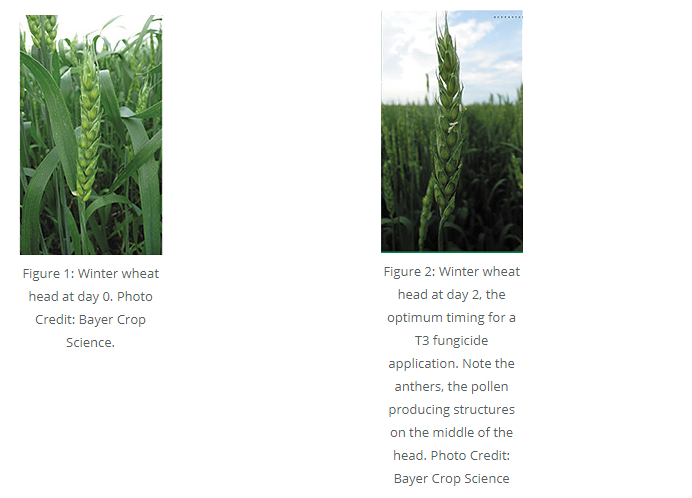
The 2019 growing season has been a challenge for the winter wheat crop to say the least! While many winter wheat fields have been removed, a significant amount of stands remain and are being kept through to harvest. Given the wet conditions so far this spring and as we approach heading in many areas, it will be important to prepare a plan for the preventative management of fusarium head blight (FHB). Many will be busy with corn and soybean planting over the next week but the timing for T3 fungicide applications should not be overlooked. Here are a few things to keep in mind when making a plan for FHB management in your wheat crop.
What fields are at the most risk?
Winter wheat is most susceptible to FHB infection during the flowering period. Spores are carried from infected crop residue by wind or rain and splash onto the wheat head. Rainfall or heavy dew during this period then causes the spores to germinate and infect florets on the wheat head. Given the continued wet conditions in many areas, the risk for infection may be higher this year.
If your wheat crop was planted after corn or wheat or a susceptible variety was planted, your risk of FHB infection is greater and a preventative fungicide application is recommended. To determine the susceptibility of a variety please visit www.GoCereals.ca under the performance tab.
You can also assess the risk of your wheat field by utilizing the DON prediction model, DONcast. DONcast allows you to enter the location of your field along with the estimated heading date to determine the risk in a particular field. If the model suggests the risk for DON accumulation is medium to high and you are growing a susceptible or moderately susceptible variety a fungicide application is warranted. If the risk is low and you are growing a moderately resistant variety a fungicide application may not be necessary. For more information on DONcast please visit: http://www.weathercentral.ca/. DONcast is a free tool that can be viewed by creating a login and password.
When should I apply my preventative fungicide?
Once 75% of the heads on the main stem reach GS59 (head emergence complete) this is known as “day 0” (figure 1). The optimum fungicide application timing is shortly after this on “day 2”. Day 2 is the beginning of pollination when anthers are visible on the middle of the wheat head (figure 2). This timing is critical because this is when the peak number of florets are open and susceptible to infection. If temperatures are warm during this period it could result in the wheat crop moving quickly through these growth stages so it will be important to track the staging of your wheat crop as it approaches heading (GS59).

There is a significant amount of variation in wheat stands across the province. Even fields that were planted early, in fit conditions with an optimum seeding depth have some variation due to the weather conditions this winter and spring. When determining the optimum timing for fields with a variable stand, target the application when most of the wheat plants are at the correct stage. While some heads, particularly the tillers, may be too early or too late during application, targeting your application when the majority of the crop is at the correct stage, is the best option.
Which fungicides should be applied?
While there are a number of fungicides available for disease control in winter wheat, there are only few that can be applied at the T3 fungicide timing. Metconazole and prothioconazole + tebuconazole are the two products that can be applied for prevention of FHB. All other fungicides do not provide adequate protection against FHB.
Additionally, it is important to avoid applying any fungicides from the strobilurin class of fungicides as these have been shown to increase DON levels in winter wheat when applied at the T3 timing.
What about two applications? Two fungicide applications at heading is generally not economical, particularly in those fields with lower yield potential. It is also important to follow the label for pre-harvest interval restrictions.
For more information please see the Fungicide Efficacy Table for Control of Wheat Diseases NCERA 184.
What else should I consider and be looking out for?
While leaf diseases have been relatively low this year, as temperatures begin to rise the conditions may become more conducive for diseases such as powdery mildew, septoria and stripe rust. Continue to monitor for disease leading up to your T3 fungicide timing and if no disease is present, stay the course. Once your T3 fungicide is applied it will also protect against some leaf diseases. If you come across stripe rust and it is spreading quickly, you may need to apply a fungicide if your variety is susceptible and you are more than one week away from the T3 fungicide application. For more information on managing stripe rust please see Effectively Managing Stripe Rust.
Before getting out to the field to spray your wheat, ensure your sprayer has been adequately cleaned, you are using the appropriate nozzles (i.e. such as forward-and-back double nozzles or alternating turbo floodjets) and adequate water volumes (18-20 gallons/acre).
Source : Field Crop News